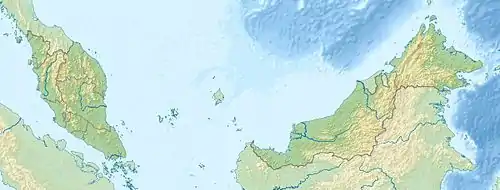| Mount Mulu | |
|---|---|
 Mount Mulu Summit in the evening | |
| Highest point | |
| Elevation | 2,376 m (7,795 ft) |
| Prominence | 2,025 m (6,644 ft) |
| Listing | Ultra Ribu |
| Coordinates | 4°03′00″N 114°55′59″E / 4.05°N 114.933°E |
| Naming | |
| Native name | Gunung Mulu (Malay) |
| Geography | |
 Mount Mulu Location within Malaysia | |
| Location | Miri Division, Sarawak, Malaysia |
Mount Mulu (Malay: Gunung Mulu) is a sandstone and shale mountain. At 2376 m, it is the second highest mountain in the state of Sarawak, after Mount Murud. It is located within the boundaries of Gunung Mulu National Park, which is named after it.
History
In the 19th century, Spenser St. John and Charles Hose, attempted to conquer Mount Mulu. However, their attempts failed. It was only in the 1920s, when a Berawan rhino hunter named Tama Nilong discovered the south-west ridge near the mountain which eventually led to the summit. In 1932, Tama Nilong led Lord Shackleton and an Oxford University Expedition to the summit of Mount Mulu.[1]
Climbing route
There is only one trek leading to the summit of Mount Mulu.[1] The summit is located at 24 km away from the park headquarters. The trek starts from the national park headquarters to reach Camp 3. It is a 12 km hike through the primary forests with an elevation of 1,200 metres. The mossy forest starts from Camp 3. It will be a few hours to climb to reach Camp 4. After Camp 4, there are a few vertical climbs which requires knotted ropes which eventually leads to the summit. Camp 1 is located along the descending trek from the summit of Mount Mulu. There is another 3-hour hike to reach the park headquarters from Camp 1.[2]
Biodiversity
Mulu's limestone karst and isolated mountain peaks are home to many unique and endangered plants and animals. The mountain has biological systems range from lowland dipterocarp forest to montane vegetations. The mountain is notable for its pitcher plant diversity. Five species have been recorded from Mount Mulu: Nepenthes hurrelliana, Nepenthes lowii, Nepenthes muluensis, Nepenthes tentaculata, and Nepenthes vogelii.[3]
References
- 1 2 "Treks and Trails in Mulu". Gunung Mulu National Park. Archived from the original on 22 August 2018. Retrieved 27 October 2018.
- ↑ Lee, Yu Kit. "Stepping into another world". The Star (Malaysia). Archived from the original on 27 October 2018. Retrieved 27 October 2018.
- ↑ Bourke, G. 2011. The Nepenthes of Mulu National Park. Carniflora Australis 8(1): 20–31.